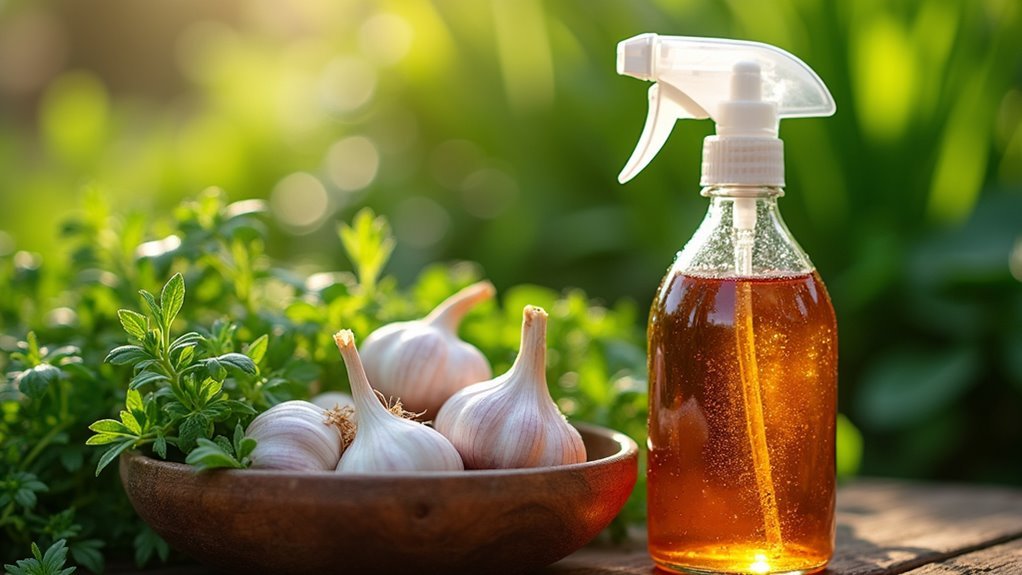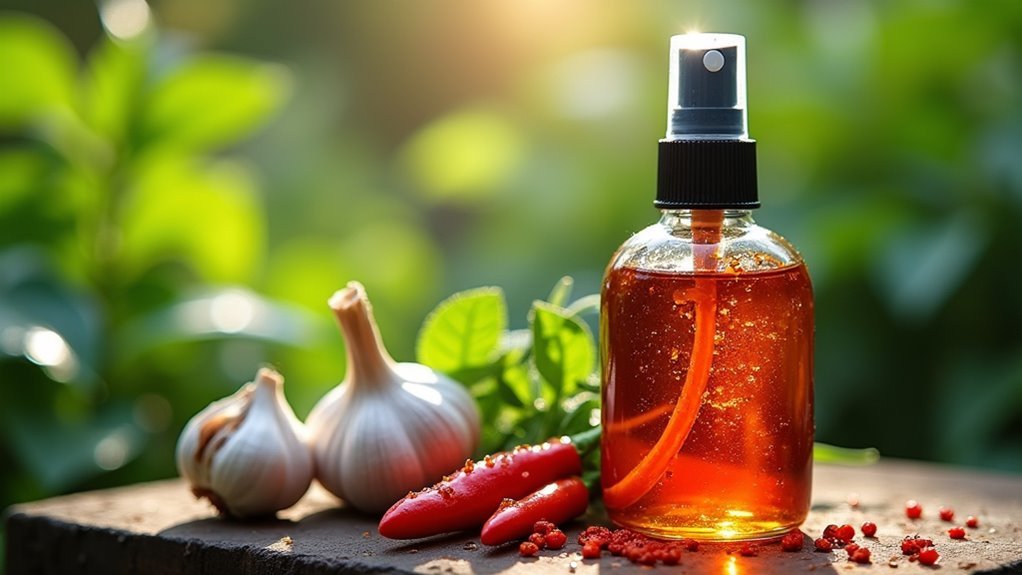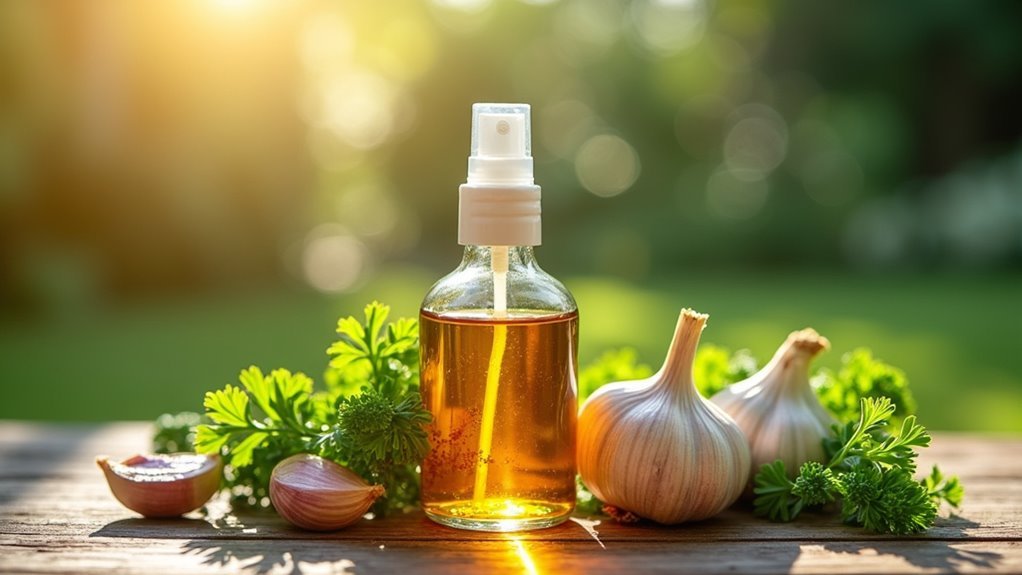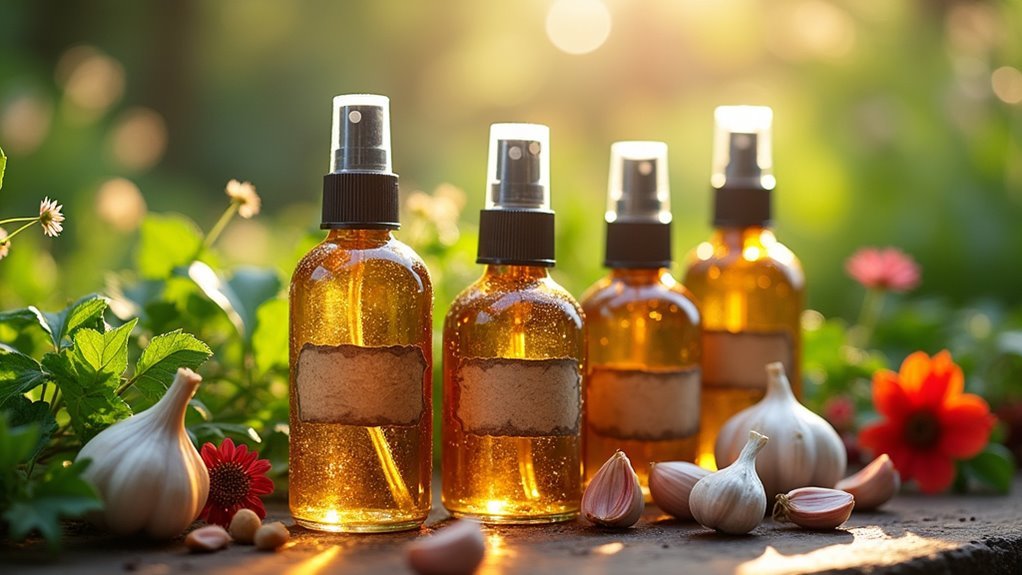You can create effective garlic sprays by crushing four garlic cloves with four cups of water and dish soap, then diluting 1:10 before applying weekly. For enhanced pest control, you’ll add neem oil or combine garlic with cayenne pepper and onions for stubborn invaders. Mix garlic with vinegar for fungal issues, or blend with mint leaves for wider insect protection. Apply during evening hours and reapply after rainfall for maximum effectiveness against aphids, slugs, and powdery mildew. These natural solutions offer extensive garden protection strategies.
Basic Garlic Plant Spray Recipe

When garden pests threaten your plants, you can create an effective defense with just a few household ingredients. This basic garlic spray recipe requires crushing four garlic cloves and mixing them with four cups of water and four to five drops of liquid dishwashing soap.
You’ll need to strain the mixture through cheesecloth or a coffee filter to remove all garlic bits before transferring it to your spray bottle.
Before application, dilute the concentrated garlic mixture with water at a 1:10 ratio. Apply this garlic spray weekly to affected plants, or twice weekly during rainy periods. Make sure you cover both leaf surfaces thoroughly.
Store unused spray in a cool location, but use it quickly since its effectiveness decreases over time.
Enhanced Garlic Spray With Neem Oil
While the basic garlic spray provides solid pest protection, you can greatly boost its effectiveness by adding neem oil to create a more powerful defense system. This enhanced garlic spray combines garlic’s natural repelling properties with neem oil’s insecticidal capabilities, disrupting pest life cycles while remaining completely safe for edible plants.
| Ingredient | Amount | Purpose |
|---|---|---|
| Concentrated Garlic Spray | 1 part | Base repellent |
| Water | 10 parts | Dilution medium |
| Neem Oil | 1-2 teaspoons | Insecticide booster |
| Application Frequency | Every 5-7 days | Maintenance schedule |
| Target Areas | Leaf undersides | Maximum coverage |
Focus on thoroughly coating leaf undersides where pests like aphids and spider mites typically hide. Reapply after heavy rainfall to maintain potency and guarantee continuous organic protection.
Spicy Garlic Pepper Deterrent Spray

For gardeners facing persistent pest problems, the spicy garlic pepper deterrent spray delivers an aggressive defense that targets multiple pest types simultaneously.
This powerful garlic spray combines three potent ingredients to create maximum deterrent effect while protecting beneficial insects.
You’ll blend one large onion, 4-5 garlic cloves, and 2 tablespoons of cayenne pepper in your food processor.
Let this mixture steep outside for several hours, then strain it into a gallon jug.
Add 2 tablespoons of peppermint Castile soap and fill with water.
Apply directly onto affected plants, covering both leaf sides thoroughly.
This natural deterrent eliminates your need for synthetic pesticides while maintaining a healthy garden ecosystem, making it an environmentally responsible pest control solution.
Garlic Soap Solution for Aphid Control
When you’re battling aphids, adding dish soap to your garlic spray creates a powerful one-two punch that’s more effective than garlic alone.
You’ll need to target both leaf surfaces with proper application techniques to reach aphids hiding on undersides where they typically feed.
Getting your dilution ratios right guarantees you’ll eliminate pests without harming your plants.
Soap Enhances Garlic Effectiveness
Since garlic alone can sometimes struggle to stick to smooth plant surfaces and insect bodies, adding a small amount of liquid dish soap transforms your spray into a more potent weapon against aphids.
The soap functions as a surfactant, breaking down insects’ waxy protective coatings and allowing garlic’s toxic compounds to penetrate more effectively.
You’ll create a double-action solution that repels pests with garlic’s strong scent while simultaneously suffocating them through soap’s coating properties.
This enhanced adhesion means your garlic spray stays put longer on leaves and stems, providing extended protection.
The surfactant action also helps the mixture spread evenly across plant surfaces, ensuring thorough coverage that maximizes your pest control efforts throughout the garden.
Aphid-Targeting Application Methods
Proper application techniques determine whether your garlic soap solution effectively eliminates aphids or merely provides temporary relief.
Create your mixture by combining 1 teaspoon olive oil with 1 teaspoon dish soap in 1 gallon of water, guaranteeing you’ve properly extracted compounds from garlic cloves beforehand. Test the solution on a small, hidden plant section first, waiting 1-2 days for adverse reactions.
Target aphids by spraying directly onto affected plants, concentrating on leaf tops and undersides where they cluster. Don’t miss hidden areas where colonies establish themselves.
Reapply every few days and after rainfall to maintain effectiveness. Regular monitoring guarantees you catch new infestations early. This consistent approach keeps aphid populations controlled while supporting your garden’s overall health and ecosystem balance.
Safe Dilution Ratios
Getting the dilution ratios right means the difference between protecting your plants and accidentally damaging them with an overly concentrated garlic soap solution.
When creating your aphid-fighting mixture, you’ll want to follow these safe dilution ratios to guarantee maximum effectiveness without harming your garden:
- Basic Solution: Mix 1 teaspoon of dish soap with 1 gallon of water, then add 1-2 tablespoons of concentrated garlic mixture.
- Garlic Concentrate: Dilute your garlic mixture at a 1:10 ratio with water before application to prevent plant damage.
- Test Application: Always test the solution on a small, hidden area first to check for adverse reactions.
These safe dilution ratios provide effective aphid control while protecting your plants from potential chemical burn or stress.
Herbal Garlic Mint Combination Spray
You’ll find that combining garlic with mint creates a more powerful pest deterrent that targets a broader range of insects while reducing the strong garlic smell.
The preparation involves blending 4 crushed garlic cloves with 1 cup of fresh mint leaves in 4 cups of water, then straining the mixture and adding a few drops of dish soap for better plant adhesion.
Apply this enhanced spray weekly or after rainfall to maintain consistent pest protection without compromising the taste of your edible plants.
Mint Garlic Preparation Method
Creating an effective mint garlic spray requires just three simple ingredients that’ll transform your garden’s pest control strategy.
You’ll blend garlic cloves, water, and fresh mint leaves to make garlic spray that naturally repels harmful insects while protecting beneficial ones.
Follow these essential preparation steps:
- Blend the base mixture – Combine 1/4 pound garlic cloves with 1 cup water and 1/2 cup fresh mint leaves until smooth.
- Strain thoroughly – Pour the mixture through cheesecloth to remove all solids and create a concentrated liquid.
- Dilute for application – Mix one part concentrate with ten parts water before transferring to your spray bottle.
Apply this solution during early evening hours to maximize effectiveness and prevent leaf burn.
Reapply weekly or after rainfall to maintain consistent pest protection throughout your growing season.
Enhanced Pest Deterrent Properties
Beyond its simple preparation, the garlic mint combination delivers remarkable pest-fighting power through its dual-action formula.
When you make your own garlic mint spray, you’re harnessing allicin from garlic and menthol from mint working together to confuse and repel garden pests. This synergistic effect makes the combination especially potent against aphids, spider mites, and other unwanted insects that typically plague your plants.
For maximum effectiveness, apply your spray during evening hours when pests are most active and plants are dry, reducing leaf burn risk.
You’ll need to reapply weekly or after rainfall to maintain protection. The dual compounds create a powerful deterrent barrier that greatly improves plant health while keeping harmful insects at bay throughout your growing season.
Application Timing and Frequency
Since timing directly affects your spray’s success rate, apply your herbal garlic mint combination during early evening hours when temperatures drop and pest activity peaks.
This application timing prevents plant stress while targeting pests when they’re most vulnerable.
Your spray frequency should follow this schedule:
- Regular maintenance: Reapply every 7-10 days for consistent pest control
- Post-rainfall treatment: Increase frequency to twice weekly after rain washes away residue
- Initial testing: Always test on a small plant area before full application
You’ll achieve maximum effectiveness by thoroughly covering leaf tops and undersides where aphids and spider mites hide.
Store unused spray in cool, dark conditions and use within weeks to maintain potency.
Proper application timing and consistent frequency create an effective barrier against garden pests.
Anti-Fungal Garlic Treatment Recipe
When fungal diseases like powdery mildew threaten your garden, you’ll need a potent garlic-based treatment that goes beyond basic pest deterrence.
This anti-fungal garlic treatment recipe starts by blending one head of garlic with 235 ml of water to create a concentrated purée. Next, add 700 ml of water and 30 ml of liquid soap to enhance the mixture’s effectiveness against fungal infections.
Let the solution steep for at least 12 hours, then strain it through cheesecloth to remove garlic chunks.
Apply the smooth spray directly to affected foliage during evening hours, ensuring you cover both leaf surfaces thoroughly. Reapply every few days or after rainfall to maintain consistent protection against fungal diseases throughout your garden.
Concentrated Garlic Oil Infusion Spray

For even stronger pest control power, a concentrated garlic oil infusion spray offers superior protection against stubborn garden invaders.
This potent solution harnesses garlic’s natural toxins to effectively combat aphids, slugs, and other persistent pests that standard sprays can’t handle.
Creating your concentrated garlic mixture requires patience but delivers exceptional results:
While this concentrated garlic solution demands more time and effort, the superior pest control results make every step worthwhile.
- Steep minced garlic in mineral oil for 24 hours to extract powerful compounds.
- Strain the mixture thoroughly to remove all garlic solids.
- Mix 2 tablespoons of strained garlic oil with dish soap and one pint of water for your spray solution.
Before applying this concentrated formula to your entire garden, you’ll want to test it on a small plant section first.
This precaution guarantees your plants won’t experience any adverse reactions to the potent garlic infusion.
Garlic Vinegar Multi-Purpose Garden Spray
You’ll find that combining garlic with vinegar creates one of the most versatile pest control solutions for your garden.
This powerful spray requires specific mixing ratios and proper application techniques to maximize its effectiveness against both insects and fungal diseases.
Understanding how to store this mixture properly will guarantee you’ve got a reliable garden defense ready whenever pests threaten your plants.
Vinegar Garlic Recipe Basics
One powerful combination transforms your garden’s pest control strategy: vinegar and garlic working together in a simple spray solution.
These vinegar garlic recipe basics create an effective deterrent that’ll protect your plants from multiple threats simultaneously.
Your garlic spray requires just three essential components:
- Base liquid: 1 quart of water mixed with 1 cup of vinegar
- Active ingredient: 4-5 cloves of crushed garlic for maximum potency
- Steeping time: At least 12 hours for proper infusion
Make sure you strain the mixture through cheesecloth before application to remove garlic particles.
This creates a smooth spray that won’t clog your equipment.
The resulting solution effectively repels aphids and slugs while fighting fungal problems, giving you thorough garden protection in one simple recipe.
Application and Coverage Methods
Three simple timing considerations guarantee your garlic vinegar spray delivers maximum garden protection.
First, apply during early evening when temperatures cool and plants are dry, maximizing absorption while minimizing evaporation.
Second, test application on a small, inconspicuous plant area before treating your entire crop to check for adverse reactions.
Proper coverage technique matters considerably. Spray both tops and undersides of leaves thoroughly, since many pests hide underneath where they’re less exposed to natural elements.
Don’t forget these hidden areas during application.
Maintain effectiveness through consistent reapplication every few days or immediately after rainfall.
Weather conditions quickly diminish the spray’s potency, so regular coverage ensures continuous pest deterrence and fungal prevention throughout your growing season.
Storage and Shelf Life
While proper application guarantees immediate effectiveness, storing your garlic vinegar spray correctly determines how long it’ll remain potent for future garden treatments. Your homemade solution maintains its pest-fighting power for up to two weeks when stored properly in cool, dark conditions.
Follow these essential storage guidelines:
- Label containers with preparation dates to track freshness and guarantee timely use before potency diminishes.
- Refrigerate the mixture to extend shelf life beyond the standard two-week period and preserve active compounds.
- Avoid direct sunlight and extreme temperatures that’ll degrade the spray’s effectiveness during storage.
Monitor your spray regularly for unusual odors or appearance changes. If you notice anything suspicious, discard the batch immediately and prepare fresh solution for peak garden protection results.
Quick Emergency Garlic Pest Spray
Garden pests don’t wait for convenient timing, so you need a garlic spray recipe that works fast when trouble strikes.
To make this DIY Garlic Spray, blend 4 minced garlic cloves with 1 pint of water using a food processor. Let this simple garlic mixture steep for several hours, then strain. Add 1 tablespoon of dish soap to help the solution stick to leaves and keep pests away effectively.
Use garlic spray in a spray bottle for immediate application. Be sure to spray both leaf tops and undersides where bugs like to hide.
This emergency treatment works against aphids, slugs, and powdery mildew in your vegetable garden. Always test first on a small area to protect beneficial insects that love garlic-treated plants. Reapply every few days for continued protection.
Long-Lasting Garlic Storage Solution
Since you’ll be harvesting garlic throughout the growing season, proper storage becomes essential for maintaining your spray-making supply year-round.
You’ll want to store your garlic bulbs in a cool, dry location with excellent air circulation, ideally between 60-65°F. Keep them away from direct sunlight and moisture to prevent sprouting and spoilage.
For ideal storage, use these methods:
- Mesh or paper bags – Allow proper airflow while preventing mold growth
- Braided garlic strings – Traditional method that maximizes air circulation around each bulb
- Airtight refrigerator containers – Best for pre-peeled or chopped garlic, lasting up to one week
Avoid refrigerating whole bulbs, as cold temperatures and humidity encourage sprouting.
For long-term preservation of prepared garlic, freezing works excellently for your future spray recipes.
Frequently Asked Questions
How Do I Make Garlic Spray for My Garden?
You’ll crush 4 garlic cloves, mix with 4 cups water and 4-5 drops dish soap. Strain the mixture, dilute 1:10 with water, then transfer to a spray bottle for application.
How to Make Garlic Spray for Plants in Gardeners World?
You’ll crush 4 garlic cloves, mix with 4 cups water and dish soap drops. Strain the mixture, dilute 1:10 ratio, then spray weekly on plant leaves’ tops and undersides.
How Long Does Garlic Spray Keep Mosquitoes Away?
Garlic spray keeps mosquitoes away for 4-6 hours after you apply it. You’ll need to reapply every few hours for continued protection, especially in humid, windy, or rainy conditions that reduce its effectiveness.
What Pests Does Garlic Spray Repel?
You’ll repel aphids, slugs, spider mites, cotton aphids, cabbage flies, and houseflies with garlic spray. The sulfur compounds and allicin disrupt pests’ sensory receptors, confusing them and preventing feeding on your plants.
In Summary
You’ve now got ten proven garlic spray recipes to tackle any garden pest problem. Don’t hesitate to experiment with different combinations based on what’s attacking your plants. Remember to test spray a small area first and reapply after rain. Store your homemade sprays properly and they’ll stay effective longer. With these natural solutions in your gardening toolkit, you’ll keep pests away without harsh chemicals harming beneficial insects.





Leave a Reply